Where to Stay in Kauai
Kauai is defined by its spectacular scenery, secluded beaches, and laid back personality. Although only 25 miles long and 33 miles wide, the island contains a remarkable variety of landscapes, attractions and weather. Given this diversity, deciding where to stay in Kauai deserves some careful consideration. The following guide will help you choose the region that suites you the best.
It's convenient to separate Kauai into 4 regions - the North, East, South, and West coasts. At the center of the island is Mount Wai'ale'ale - 5148 ft above sea level and famed for being the wettest recorded place on the planet.
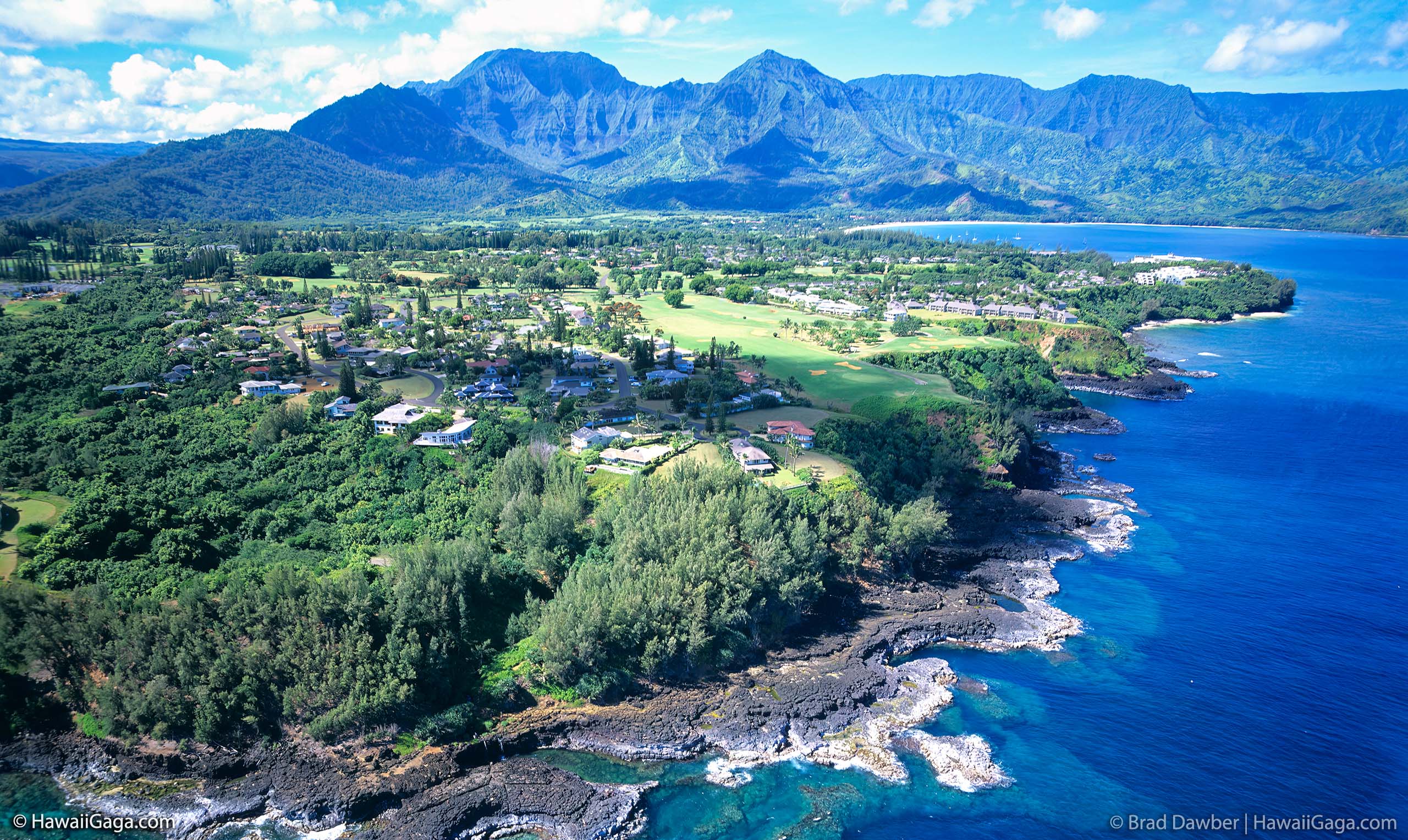 Kauai's majestic north shore. The resort town of Princeville offers many good vacation homes and condo options
Kauai's majestic north shore. The resort town of Princeville offers many good vacation homes and condo options
The North Shore
For many, Kauai's north shore represents what a tropical Hawaiian paradise looks like. Mountains with waterfalls, lush valleys, and miles of palm fringed beaches. The weather is ideal for growing fruits and vegetables and a fair amount of land is set aside for small farms. The rugged mountains of the Napali coast, accessible by the famous Kalalau Trail, extend for 12 miles along the northwest section of the island. The north shore is sparesly populated (perhaps 6,000 residents), but the small towns of Kilauea, Hanalei and the resort community of Princeville provide a variety of nice restaurants, shops, and markets.
The North shore receives a fair amount of rain, and far away storms in the North Pacific send big waves to the coast in the Winter months. This is an exciting time for surfers, but the rough ocean conditions also make several favorite snorkeling and swimming spots unusable except during lulls in the surf. In the summer months calm ocean conditions prevail.
The East Coast
Kauai's east coast is the busiest section of the island and where most residents live. This area is considered "central" because it’s roughly the same distance to the north and south shore’s attractions (the highway doesn’t circumnavigate the island – it ends at the Napali coast). Here you'll find several small shopping centers, restuarants, and some interesting beaches including Lydgate beach park - one of the safest places to learn how to snorkel or swim. Lihue is the capital of Kauai but the towns of Wailua and Kapaa are the tourist epicenters of the east coast.
 Wailua on Kauai's Eastern Coast
Wailua on Kauai's Eastern Coast
The South Coast
Kauai's south shore is defined by the Poipu resort, Kauai's most popular tourist area. Drier weather, several nice beaches, 3 hotels and a large selection of condos contribute to Poipu's popularity. Just north of Poipu is Koloa, a small town dating back to the plantation era that now hosts a variety of tourist shops. Further north is the residential town of Kalaheo. Some of Poipu's charm comes from the fact that sections of the coast here remain undeveloped. As required by more recent Kauai building codes, you won't find a building higher than a coconut tree (4 stories).
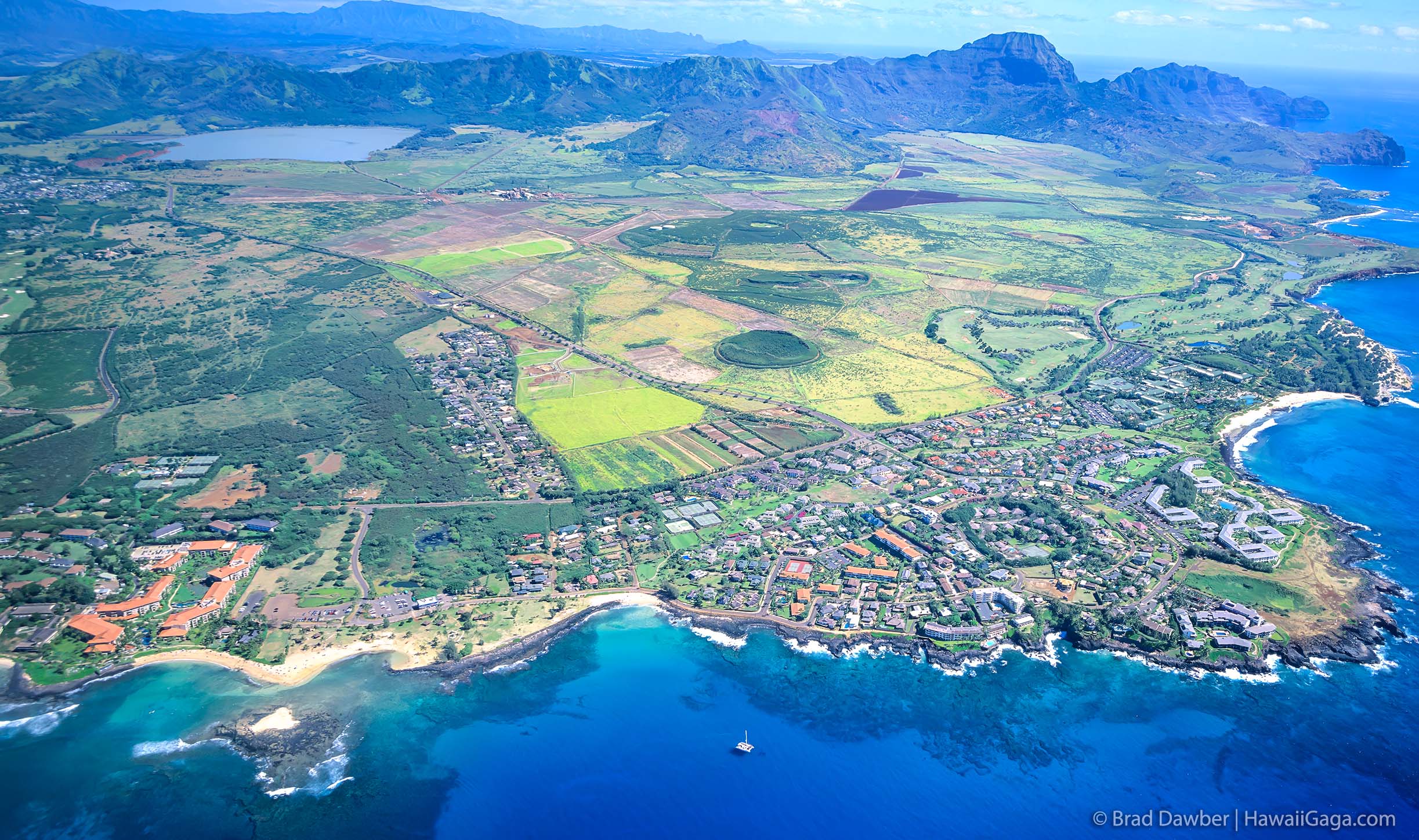 The Eastern Section of Poipu, From Poipu Beach Park to Shipwreck Beach
The Eastern Section of Poipu, From Poipu Beach Park to Shipwreck Beach
The West Side
Kauai's arid west coast is mostly undeveloped. Two attractions in this area stand out - Waimea Canyon and Polihale State park. Waimea Canyon, coined the Grand Canyon of the Pacific, is yet another wonder of the Hawaiian Islands and a must see attraction. Remote Polihale is Hawaii's longest beach - stretching for 12 miles from Kekaha until the start of the Napali coast. The town of Waimea is located here. This is where Captain James Cook first set foot when he discovered the Hawaiian Islands in 1778.
Deciding Where to Stay
The following five factors tend to be most important considerations in deciding where to stay.
- Scenic Beauty
- Weather
- Proximity to Attractions and Activities
- Beaches and Surf Conditions
- Accommodation Choices
1. Scenic Beauty
Kauai's north shore is one of the most scenic places in Hawaii. The Hanalei Mountain range can have a dozen waterfalls flowing after heavy rain. It's always green on the north shore.
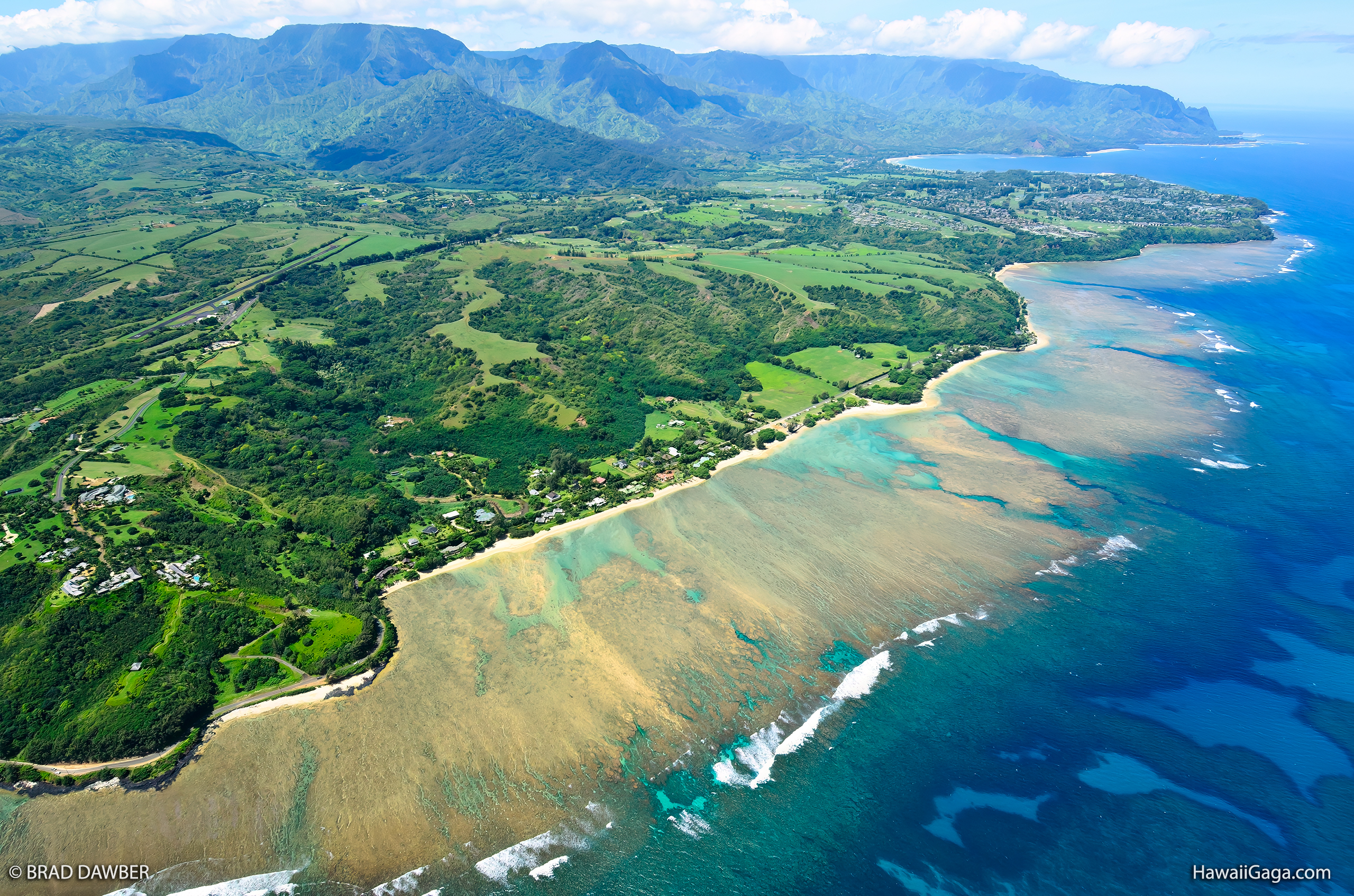
Poipu has a unique beauty of its own. There's a large section of undeveloped coast, so despite being the tourist hotspot of Kauai the area doesn't feel cramped, crowded, or over developed. You'll find plenty of green pastures and open spaces.
 Kiahuna Plantation, a beachfront condo complex in Poipu
Kiahuna Plantation, a beachfront condo complex in Poipu
While driving through Wailua and Kapaa on the east side you may be distracted by all the traffic. But turn up one of the streets toward the mountain and the scenery quickly turns rural. Here you'll find waterfalls, farms, the Wailua river and lovely mountain hikes. The famous gates from the movie Jurassic Park are located toward the base of Mount Wai'ale'ale.
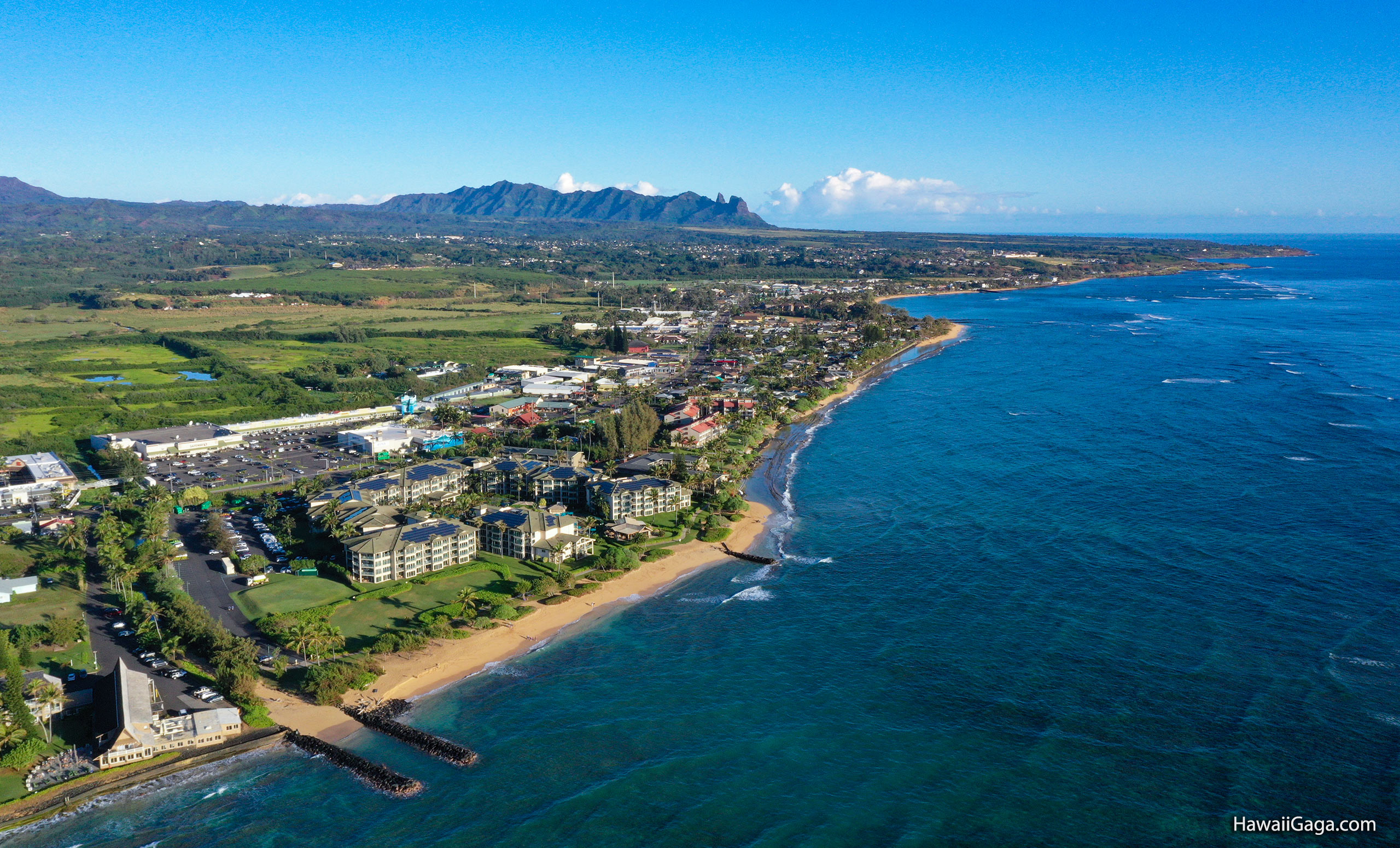 Kapa'a, Kauai. The highly rated Waipouli Beach Resort is front and center.
Kapa'a, Kauai. The highly rated Waipouli Beach Resort is front and center.
The dry conditions on the west side of the island create a landscape that's completely different. You'll get glimpses of the canyon's gorges as you drive past sleepy little Hanapepe, once one of Kauai's most vibrant towns and even boasting two movie theatres. Historic Waimea town is the gateway to the Canyon and Kokee state park where you'll find remarkable scenery and miles of hiking. Waimea is perhaps Kauai's most "Hawaiian" town, but there are very few tourist accommodations in this region.
2. Weather
Getting a grasp on Kauai's weather is difficult. Mt. Wai'ale'ale receives over 460 inches of rain per year and yet Kekaha, situated 20 miles to the SW, receives only 20 inches per year! This contradiction is due to the fact that the trade winds blow fairly consistently from East to West. Clouds collide with the mountains and in doing so are trapped until they release their moisture.
Hawaii only differentiates between two seasons. Summer lasts from May through September and "winter" claims the rest of the year. For summer time travel you don't have to factor in the weather in deciding where to stay. For winter travel the decision becomes more difficult.
First, don't rely on the personal experiences of other travelers when trying to understand what the weather will be like. Rainfall in tropical climates is characteristically varied from one year to the next especially in the winter months. For example Hilo, the wettest city in the U.S., has received less than 0.2 inches of rain in January but also more than 50 inches. Looking at historical averages will give you an idea of the overall picture, but remember it's somewhat of a lottery what you'll end up experiencing.
Keep in mind the following points:
- On average 60% of the rainfall occurs at night.
- Hawaii gets between 2 - 7 major storms per year. During a storm the entire island can experience bad weather for several days or even a week.
- In winter the wind blows from the south about 30% of the time, reversing the normal trade wind pattern. During these times the north shore will often experience better conditions than the rest of the island. These Kona winds are more common mid winter.
So What to Do?
Of the popular tourist areas, Poipu has the best weather on Kauai, so if sunshine is a major consideration select the south coast for winter travel. This is particularly true for November and March.
Stay for as long as you can, so that you can experience the "average" weather. Visiting the north shore for only a week during the winter is a gamble. If you're lucky you'll have a full week of good weather, but if you're unlucky you could see a week filled with several rainy days. By staying for a longer period you're more likely to experience an average weather pattern which will include plenty of nice days.
3. Proximity to Attractions and Activities
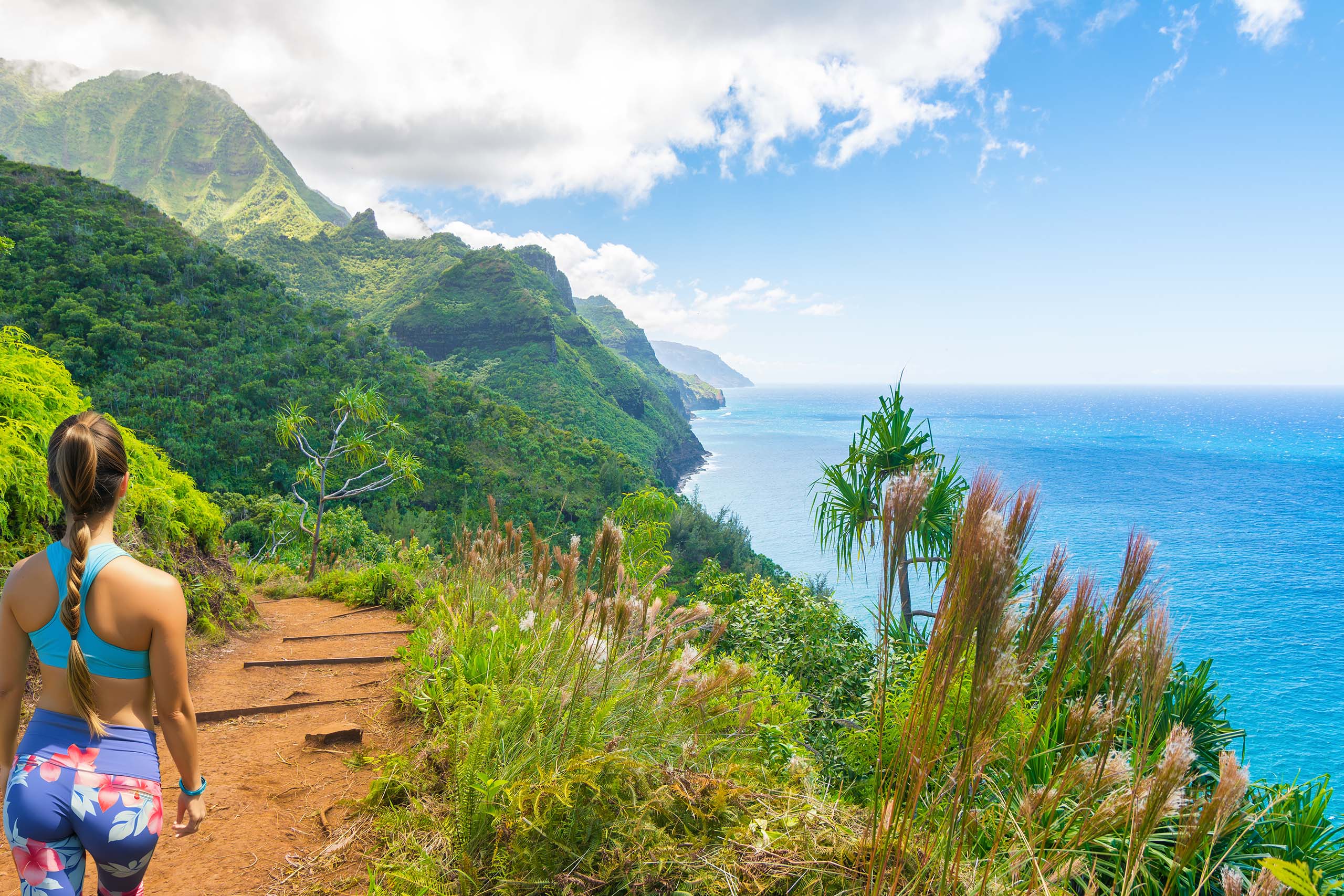 Hiking is a Popular Tourist Activity on Kauai
Hiking is a Popular Tourist Activity on Kauai
If you look at our interactive map of Kauai you'll notice many attractions scattered throughout the island. There are excellent hikes everywhere, waterfalls on the east side, snorkel spots in the south and north, many beaches on the north side, the must visit canyon on the west (which ends at the Pihea trail overlooking the Napali coast), botanical gardens in the north and south, etc. etc.
For a vacation that includes a lot of driving and exploring, consider staying on the east side which represents a central location. But remember, Kauai may be a relatively small island but you won't be able to experience everything a region has to offer with just a day trip. For this reason it's best to either situate yourself in the area with the attractions that you like the most, or to stay on the east side so that you can easily accommodate a flexible itinerary - one that will change depending on weather, surf, and you what you feel like doing that day.
The north, south and east each offer a good variety of tourist activities including zip lines, ATV tours, airplane and helicopter tours, horseback riding, boat trips etc. A popular summer time activity is boat trips along the Napali coast. They normally operate from June through September when the north shore has calmer ocean conditions. In the winter time whale watching tours are possible on the south shore. Peak whale watching season is from December to April.
4. Beaches, Surfing and Snorkeling
If you take some time to peruse our Kauai Beach guide you'll notice many interesting beaches, particularly on Kauai's north shore. Here you'll find a beach for every taste including secluded beaches, surf breaks, and snorkel spots. But as explained below, the north's beaches are fickle in the winter.
On Kauai the character of the ocean changes dramatically between seasons. Far away storms in either the northern hemisphere (winter months) or southern hemisphere (summer months) send powerful waves across the ocean where they finally make landfall on either the north or south shore.
Most northern beaches have a dual personality, often placid in the summer and very active in the winter with something in between in the spring and autumn. The same holds true for south shore beaches in the summer months, except the shift is less dramatic. East facing shores experience more consistent conditions, but both east and west are subject to wrap-around surf from the north or south. Eastern shores are often active and choppy due to wind-waves from the trade winds.
Ocean swells typically persist for a few days at a time and result in waves that vary in size from a few feet to over 25 feet depending on the severity of the distant weather system that produced the swell. In between swells the ocean will be calmer for several days at a time, subject to mostly localized wind waves. As the season transitions from winter to summer the waves start getting smaller, and the length of time between the arrival of new swells increases.
 North Shore - Average Biggest and Smallest Waves Experienced each Month. Data from Patrick Caldwell, Waimea.
North Shore - Average Biggest and Smallest Waves Experienced each Month. Data from Patrick Caldwell, Waimea.
So how often can one swim or snorkel on the north shore during the winter? Hanalei Bay is the north's main swimming, surfing and boogie boarding beach. The shape of the bay and reefs protect certain sections from big surf, particularly the area near the Pier (known as Black Pot Beach Park).
Likewise Anini beach can offer swimming even in big surf, depending on currents, because reefs cause the waves to break far from the beach. But other popular north beaches are more exposed to open ocean, and there swimming is only possible on small surf days.
Heavy rainfall can also render many north shore beaches un-swimmable for several days. Streams and rivers carry man made pollution into the ocean. Heavy rainfall can result in flooding which leads to sewage leaks and overflowing cesspools, creating brown water conditions that can take several days to clear up.
Tunnels beach is one of the main snorkel spots on the north shore. This beach features two reef formations. Snorkeling is done at the inner reef nearby the shore. The outer reef offers another barrier of protection against waves, so Tunnels can still offer snorkeling in modest surf conditions. The below chart will give you a rough idea of how many days are "snorkable" at Tunnels beach in the Winter.

The east coast has a few picturesque beaches but they're more suited for walking. Conditions tend to be poor for swimming due to currents, shallow reefs, and rocks. Possible swimming beaches include Lydgate Beach Park with its manmade tide pool, Kalapaki Bay which has the protection of a harbor, and Kealia beach.
The south shore doesn't have the selection of beaches that the north has but they do offer all the activities beach-goers love, from surfing and boogie boarding to snorkeling and exploring. And they're not as subject to weather and big surf. This video gives you an idea of what they look like.
In conclusion, if beaches are an important factor in your decision of where to stay, consider the north shore, particularly in the summer months. You'll find many beaches that are un-crowded, and even some that are barely visited. The south shore's offerings are smaller but more consistent and reliable. For the surfing enthusiast interested in the north shore, consider the shoulder months of April, May and October for great conditions.
5. Accommodation Choices
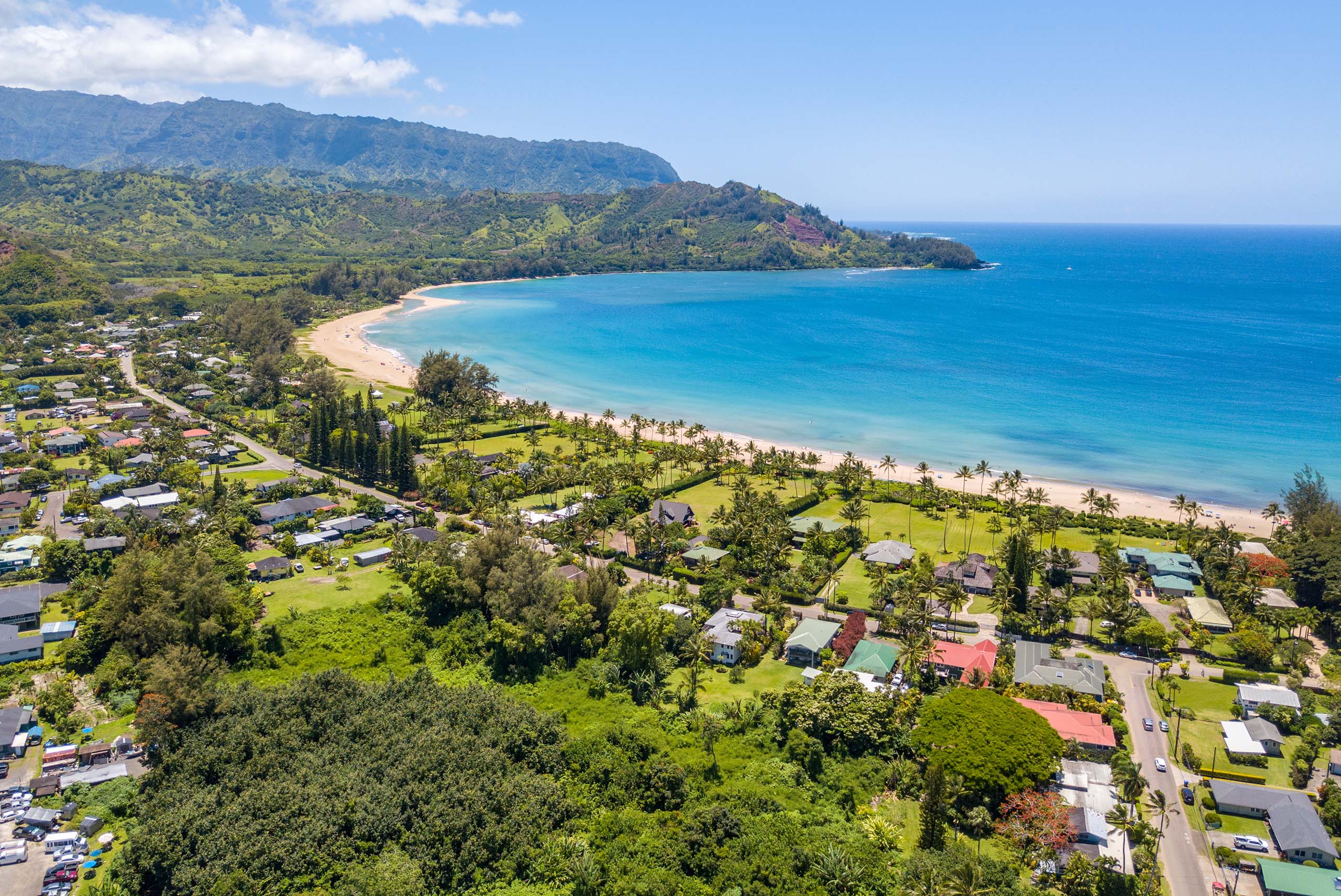 Hanalei, Hawaii's most idyllic town, offers a number of vacation homes for rent
Hanalei, Hawaii's most idyllic town, offers a number of vacation homes for rent
Kauai has a great selection of vacation rentals including a large number of vacation homes. But the island does have a problem with illegal rentals and the county is actively trying to shut them down (HawaiiGaga lists only the legal rentals, so you are safe). Take a look at our separate interactive condo guide to find a condo that matches your preferences, or our Kauai rental search page to see rentals (including homes) in different areas.
The Grand Hyatt in Poipu is Kauai's most popular 5 star hotel. The One Hotel Hanalei Bay in Princeville is another 5 star property featuring the best views of any hotel in Hawaii. The Sheraton and Koa Kea in Poipu are two other good hotel options.